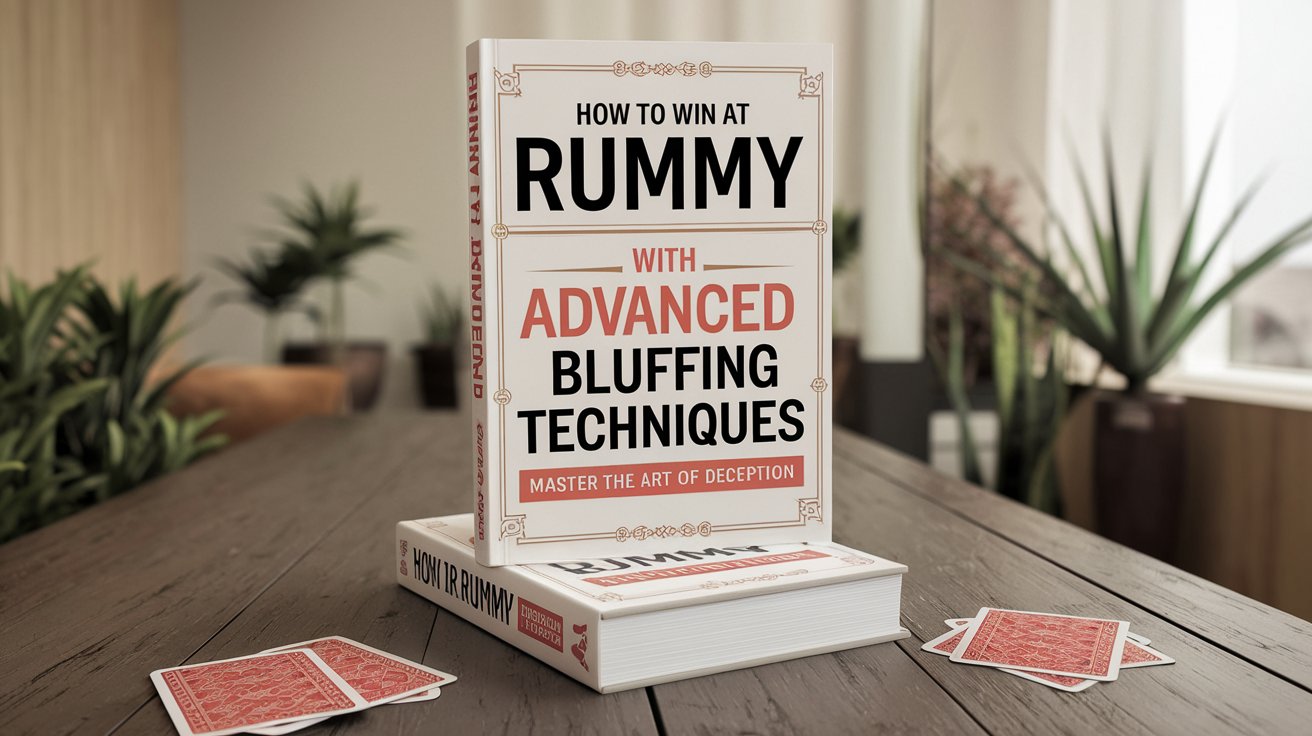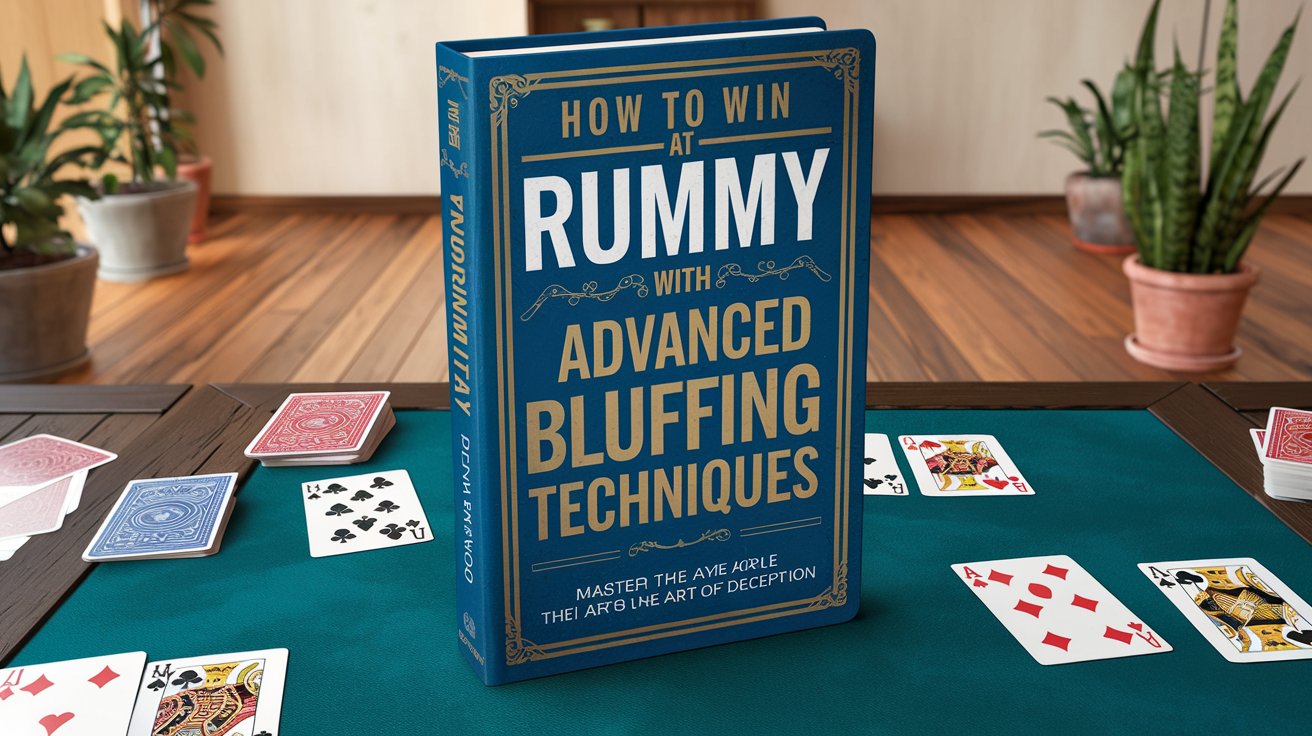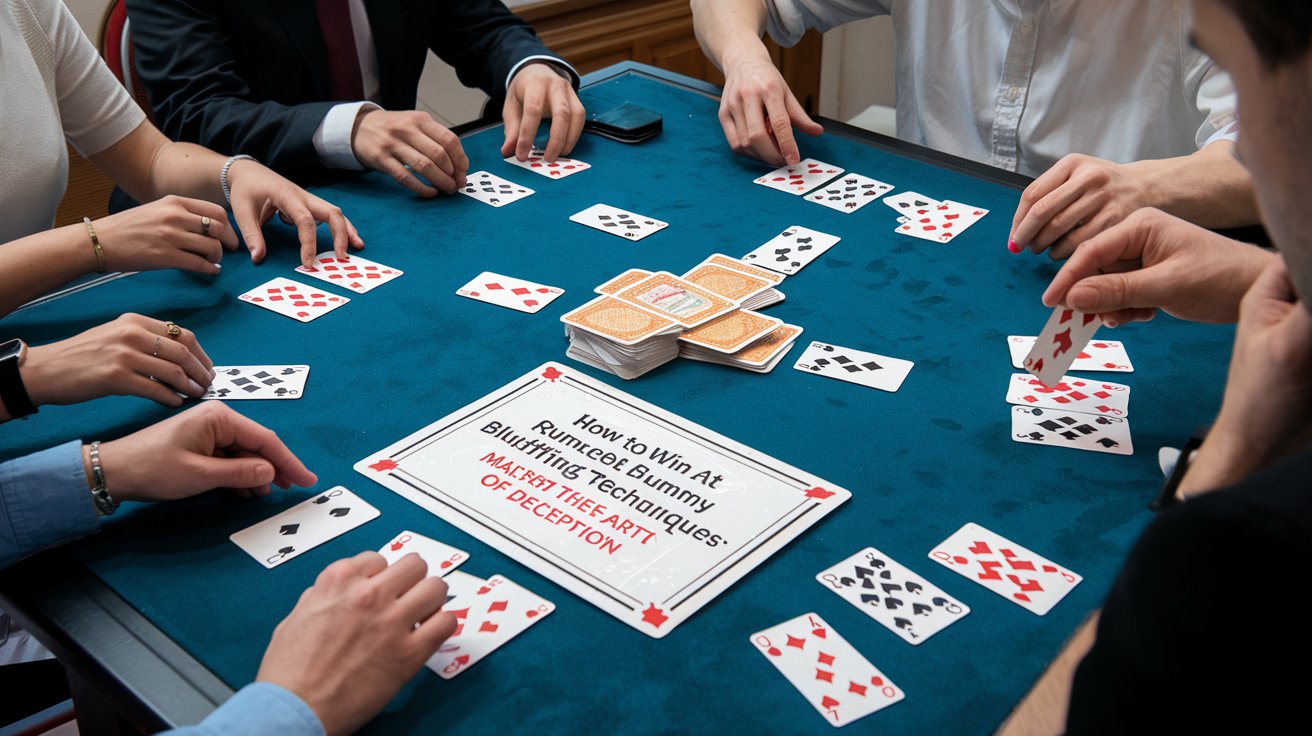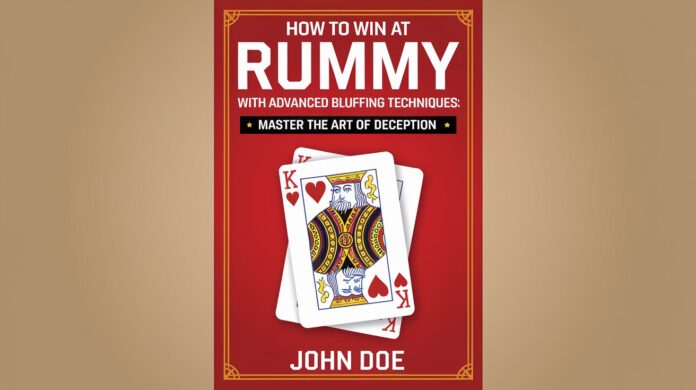Rummy is a game of skill, strategy, and psychological finesse. While many players focus on forming melds and calculating probabilities, the art of bluffing remains one of the most underrated weapons in your Rummy arsenal. Advanced bluffing techniques can transform your game by confusing opponents, protecting your hand, and creating opportunities for game-changing plays. In this comprehensive guide, we’ll dive deep into how you can win at Rummy by mastering advanced bluffing techniques, blending tactical misdirection with keen observation and psychological insight.
Introduction: The Power of Bluffing in Rummy

In the competitive world of Rummy, the best players do more than just form melds—they master the art of deception. Bluffing isn’t about lying outright; it’s a strategic maneuver that misleads your opponents, forces them into errors, and creates opportunities that you can exploit. When executed correctly, advanced bluffing techniques can be the linchpin of your strategy, making your gameplay unpredictable and your moves nearly impossible to counter.
Imagine making a move that leaves your opponent questioning their strategy, or discarding a card that they believe holds no value while secretly setting up your winning hand. That’s the power of advanced bluffing. In this guide, we’ll explore every facet of this essential tactic, from the psychology behind it to the specific techniques you can use at the table.
SEO Keywords: win at Rummy, advanced bluffing techniques, Rummy strategy, bluffing in Rummy, win at Rummy with bluffing
Understanding Bluffing in Rummy
What is Bluffing?
Bluffing in Rummy involves making moves that mislead your opponents about the true strength or composition of your hand. It’s about creating a false impression to manipulate the decisions of others. This can be achieved through various tactics such as selective discarding, timing your moves, or even using non-verbal cues.
The Role of Deception in Rummy
Deception is a vital component in Rummy because the game is as much about psychology as it is about strategy. Every card you play, every discard you make, sends a signal to your opponents. By mastering the art of bluffing, you control those signals and force your opponents to question their own moves. A well-timed bluff can disrupt your opponent’s rhythm and shift the momentum in your favor.
SEO Keywords: bluffing in Rummy, deceptive tactics in Rummy, Rummy deception strategy
Why Advanced Bluffing Techniques Matter

Gaining a Psychological Edge
At its core, bluffing is about gaining a psychological advantage. When you successfully bluff, you make your opponents doubt their own assessment of the game. This uncertainty can lead them to make mistakes or play more cautiously than they otherwise would, allowing you to capitalize on the situation.
-
Confuse and Conquer: By creating a sense of unpredictability, you keep your opponents on their toes.
-
Control Emotions: A well-executed bluff can undermine your opponents’ confidence, making them more likely to second-guess their strategies.
-
Create Pressure: When opponents are unsure of your true hand, they may rush their decisions, which often leads to suboptimal plays.
Controlling the Pace of the Game
Bluffing isn’t just a defensive tactic; it’s also a means of controlling the pace of the game. An aggressive bluff can force your opponents to react quickly, often leading to mistakes in their gameplay. Conversely, a subtle bluff can buy you time, allowing you to build a stronger hand while your opponents are caught off guard.
SEO Keywords: psychological edge in Rummy, control game pace, win with bluffing, advanced Rummy tactics
Key Elements of Advanced Bluffing Techniques
To bluff effectively in Rummy, you must master several key elements that, when combined, create a formidable strategy.
Reading Your Opponents
A successful bluffer is also a keen observer. Understanding your opponents’ behavior is crucial to knowing when and how to bluff:
-
Observation: Watch for patterns in your opponents’ discards and the way they react to certain moves.
-
Anticipation: Predict their next moves based on previous plays and adjust your bluff accordingly.
-
Adaptability: Be ready to change your strategy if you notice that your opponents are catching on to your bluffs.
Timing and Selectivity
Timing is everything when it comes to bluffing:
-
When to Bluff: Identify moments when the stakes are high, or your opponents are most likely to be distracted.
-
Selective Bluffing: Not every hand is worth a bluff. Choose your moments carefully, and know when to play it straight.
-
Strategic Pauses: Sometimes, holding back can be just as powerful as making a bold move.
Strategic Discarding
Your discards are an essential tool in your bluffing arsenal:
-
Misdirection: Discard cards in a way that suggests a different strategy from what you’re actually pursuing.
-
Deception: Let your opponents believe that certain cards are useless, when in fact, they are key to your winning meld.
-
Control: By managing your discards, you can influence which cards remain in play and which opportunities your opponents have.
Manipulating Perception
The ultimate goal of bluffing is to manipulate your opponents’ perception:
-
Fake Confidence: Exude confidence through your actions and body language, even if you’re not entirely sure of your hand.
-
Subtle Cues: Use non-verbal cues to create an image of a strong or weak hand as needed.
-
Consistency: Maintain a consistent strategy so that your bluffs are believable. Mixed signals can easily give away your true intentions.
SEO Keywords: reading opponents, strategic discarding, timing in bluffing, manipulating perception in Rummy
Advanced Bluffing Techniques in Action

Now that we’ve covered the fundamentals, let’s explore some advanced bluffing techniques that can help you win at Rummy.
Misdirection with Discards
One of the most powerful tools in advanced bluffing is misdirection:
-
Fake Weakness: Discard cards that make it seem like your hand is weaker than it actually is. This can lure your opponents into a false sense of security.
-
Create Confusion: Sometimes, discarding a card that could potentially help your opponent can be a calculated risk. If they assume you don’t need that card, they might pursue a strategy that ultimately benefits you.
-
Controlled Exposure: Deliberately expose certain cards by discarding them early. This tactic can steer the game in a direction where you control the narrative.
Feigning Confidence and Uncertainty
Bluffing isn’t just about the cards—it’s also about the persona you project at the table:
-
Exude Confidence: Use your body language to signal that you’re in control. Sit up straight, make deliberate movements, and avoid showing any signs of hesitation.
-
Feign Uncertainty: In contrast, sometimes a slight display of uncertainty can be used to your advantage. If your opponents think you’re unsure, they might overcompensate, giving you the chance to take decisive action.
-
Consistency is Key: Your overall demeanor should match your bluffing strategy. Inconsistent behavior can make it easier for observant opponents to see through your ruse.
Blending Offense and Defense
Advanced bluffing techniques often involve a delicate balance between offensive aggression and defensive caution:
-
Offensive Moves: When you’re on the attack, use bluffing to push your opponents into making rushed decisions. Bold plays can force them into errors.
-
Defensive Blocks: On the defensive side, bluffing can help you conceal the strength of your hand, preventing opponents from capitalizing on your discards.
-
Switching Gears: Be adept at shifting between offensive and defensive bluffing. This adaptability makes your overall strategy more unpredictable and harder to counter.
Utilizing Body Language and Non-Verbal Cues
Your non-verbal signals can be just as important as your card plays:
-
Subtle Gestures: Small movements—a slight nod, a change in your facial expression, or even how you handle your cards—can all be used to send the wrong signal to your opponents.
-
Control Your Emotions: Maintaining a calm and collected demeanor under pressure is a hallmark of a skilled bluffer. Let your opponents believe that you’re unflappable, even in high-stakes moments.
-
Mirror Behavior: Sometimes, subtly mimicking your opponents’ actions can lull them into complacency, making them more vulnerable to your strategic moves.
SEO Keywords: advanced bluffing techniques, misdirection in Rummy, body language in bluffing, offensive and defensive bluffing
Practical Strategies and Example Scenarios
To illustrate how these techniques work in real game situations, let’s explore a few practical scenarios.
Case Study: The Double Bluff
Imagine you’re playing a competitive Rummy game. You’re holding a hand that has the potential to form a strong sequence, but it’s not quite complete. Your opponents have been aggressive, and it appears they’re on the verge of forming a meld.
-
The Setup: You deliberately discard a card that seems unimportant, making it look like your hand is weak. Your opponents, noticing this, assume you’re not a threat.
-
The Twist: Later in the game, you pick up a crucial card from the discard pile that completes your sequence. Your earlier discard now comes back to haunt your opponents because they didn’t expect you to be holding a strong hand.
-
The Outcome: By executing a double bluff, you managed to mask the true potential of your hand and catch your opponents off guard, leading to a swift victory.
Scenario Analysis: When to Hold and When to Bluff
In another scenario, you’re in the mid-game with a hand that offers multiple possibilities. You have one card that could complete a meld, but it’s risky to reveal your intent too soon.
-
The Dilemma: Do you hold onto the card and risk being called out, or do you bluff by discarding it, hoping your opponents misread your hand?
-
The Strategy: Use a calculated bluff—discard a card that makes it seem like you’re not aiming for that particular meld. Monitor your opponents’ reactions closely.
-
The Adjustment: If your opponents begin to over-commit to a counter-strategy based on your discard, seize the moment by picking up the necessary card later and forming your meld.
-
The Outcome: Your ability to switch between holding and bluffing based on the game’s flow creates an environment where your opponents are forced to second-guess their moves.
SEO Keywords: practical bluffing scenarios, double bluff in Rummy, when to hold vs. bluff, Rummy case study
Tips for Practicing Advanced Bluffing
Mastering advanced bluffing techniques requires practice, discipline, and reflection. Here are some tips to help you sharpen your skills:
Simulated Games and Role-Playing
-
Practice Sessions: Engage in regular practice games where you focus on bluffing strategies. Simulated games can help you understand when to bluff and when to hold back.
-
Role Reversal: Play a few rounds from your opponent’s perspective. This exercise helps you understand what signals you’re sending and how they might be interpreted.
-
Controlled Experiments: Try out different bluffing tactics in low-stakes games. Over time, you’ll build a repertoire of moves that work best for you.
Post-Game Reviews and Feedback
-
Analyze Your Moves: After each game, review the key moments where you attempted a bluff. Were your signals clear? Did your opponents react as expected?
-
Solicit Feedback: If possible, discuss your gameplay with fellow players or mentors. Constructive feedback can highlight areas where your bluffing strategy can be improved.
-
Keep a Journal: Maintain a log of your games, focusing on your bluffing techniques and the outcomes. Over time, patterns will emerge that will inform your future strategy.
Mental Conditioning and Focus
-
Mindfulness Exercises: Regular mindfulness practices can improve your concentration and help you remain calm during high-pressure moments.
-
Visualization Techniques: Visualize different bluffing scenarios before playing. This mental rehearsal can prepare you to adapt quickly in real-time.
-
Stay Patient: Advanced bluffing isn’t about reckless moves—it’s about timing, precision, and maintaining your composure.
SEO Keywords: practicing bluffing, Rummy practice tips, improve bluffing skills, mental conditioning for bluffing
Avoiding Common Pitfalls in Bluffing
While bluffing is a powerful tool, overusing it or using it incorrectly can backfire. Here are some common pitfalls to avoid:
Over-Bluffing
-
Too Many Bluffs: If you bluff too frequently, opponents will start to catch on. Use bluffing selectively, ensuring that each bluff is well-timed and justified by your hand’s potential.
-
Predictability: Avoid falling into a pattern. A mix of genuine strong plays and occasional bluffs is key to maintaining unpredictability.
Inconsistent Signals
-
Mixed Messaging: Your body language and discards should tell a consistent story. Inconsistencies can alert your opponents to your true intentions.
-
Overexposure: Don’t reveal too much information through your actions. Subtlety is key when it comes to advanced bluffing.
SEO Keywords: avoid over-bluffing, pitfalls in Rummy bluffing, consistent bluffing strategy
Conclusion: Elevate Your Rummy Game with Advanced Bluffing
Advanced bluffing techniques can be a game-changer in Rummy, allowing you to control the flow of play, manipulate your opponents’ perceptions, and create winning opportunities even in challenging situations. By mastering the art of deception through well-timed discards, psychological cues, and strategic risk management, you can transform your gameplay from predictable to formidable.
Key Takeaways
-
Strategic Deception: Bluffing in Rummy is not about deception for its own sake—it’s a calculated strategy that, when executed properly, confounds your opponents and creates openings for victory.
-
Read and Adapt: A successful bluffer is also an astute observer. Constantly read your opponents and adjust your strategy based on their reactions.
-
Timing is Crucial: Whether you’re misdirecting with discards or feigning confidence, knowing when to make your move is essential.
-
Practice Makes Perfect: Regular practice and post-game analysis will refine your bluffing techniques, making them an integral part of your winning strategy.

Zareb Saleh is a journalist at Gulf Today and a ghostwriter for Gameoholic, specializing in gaming, technology, and digital culture. With a keen eye for industry trends, he delivers insightful stories that engage and inform readers.




